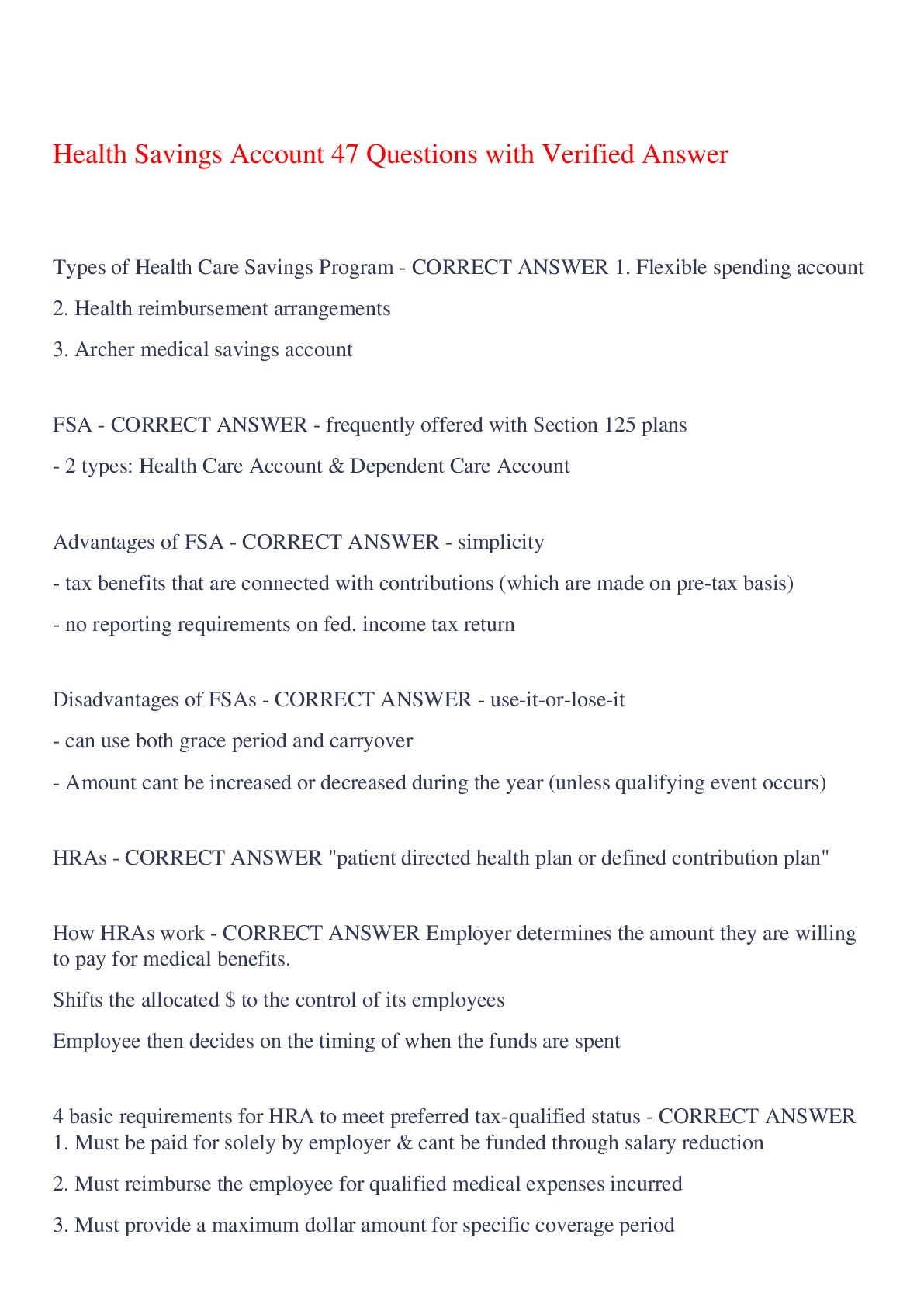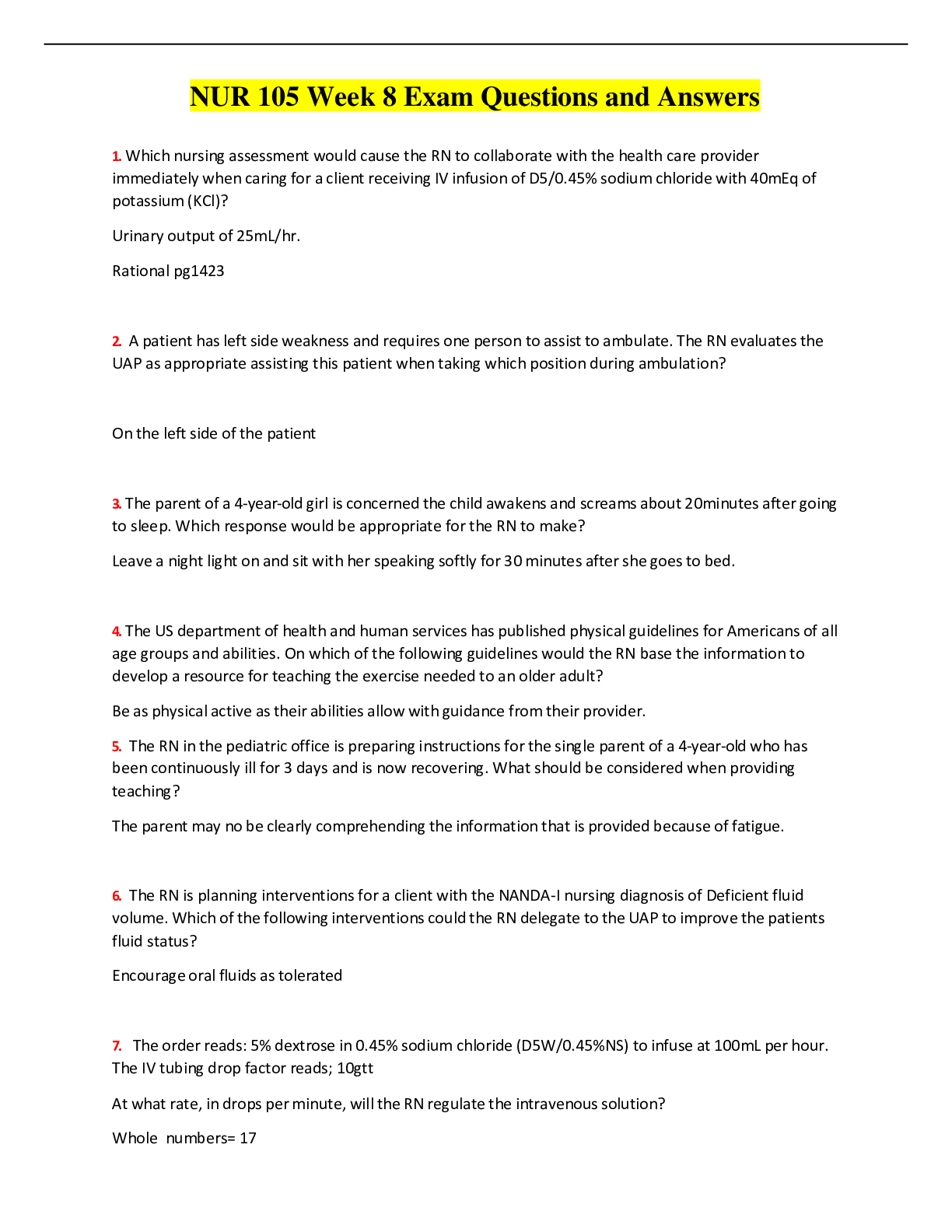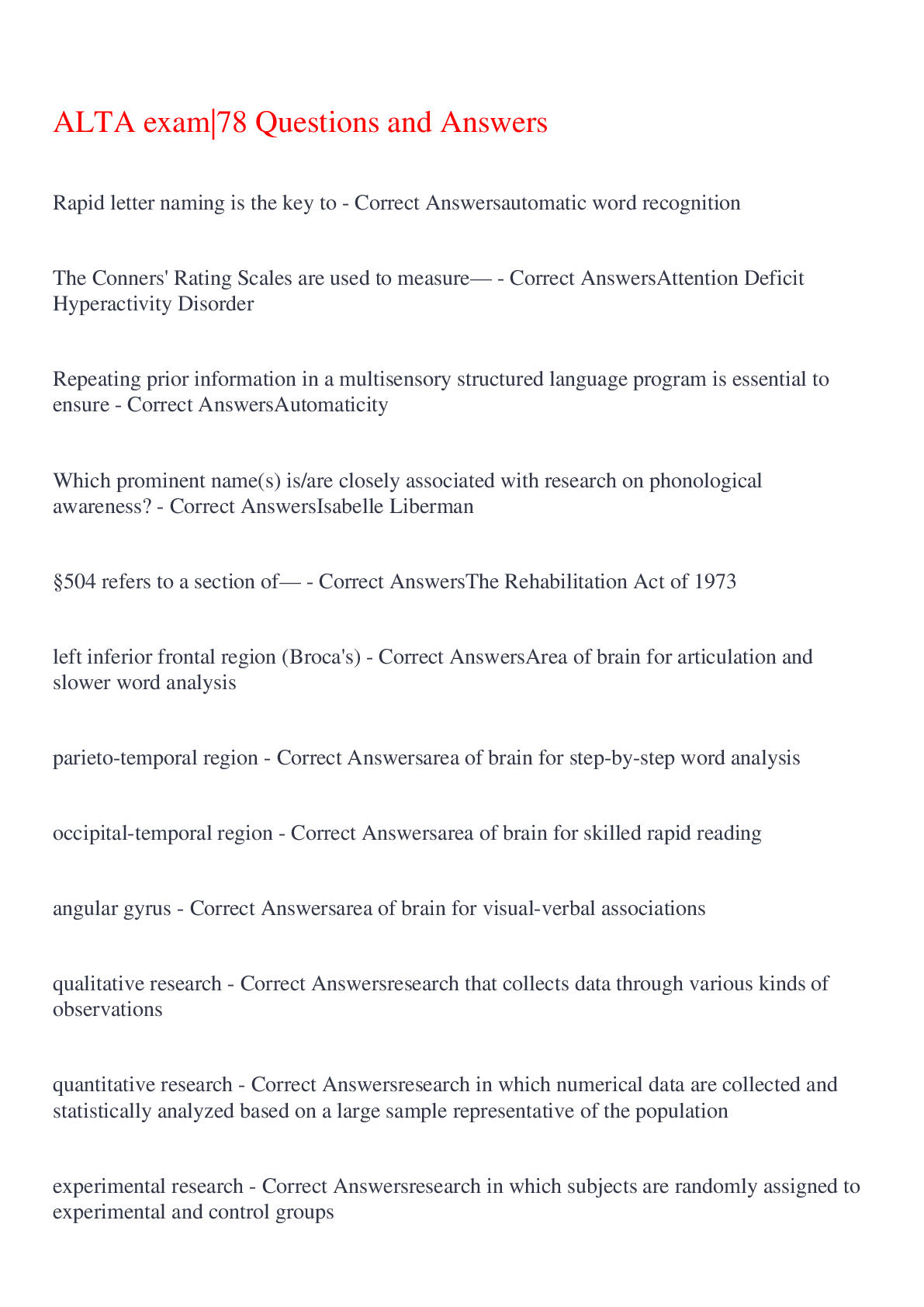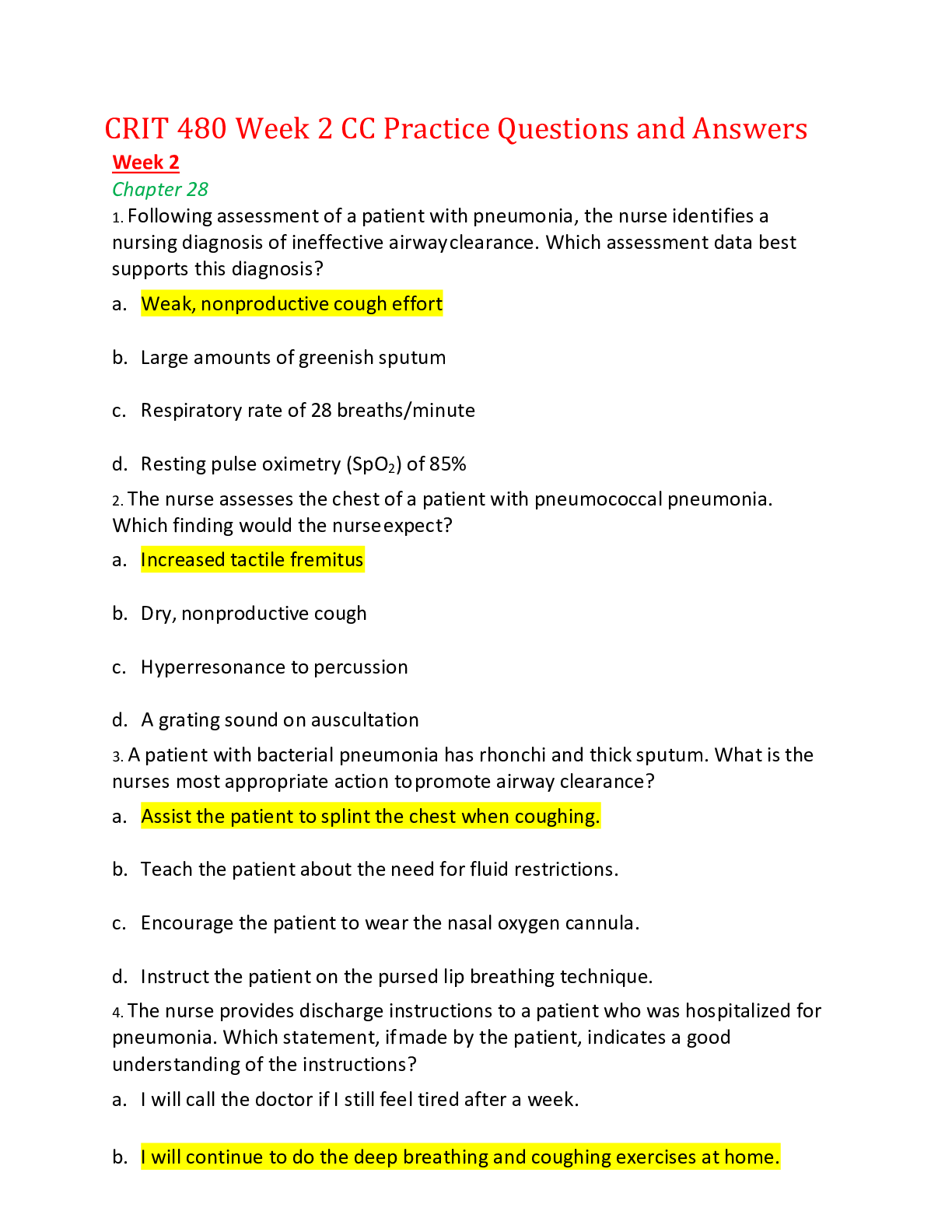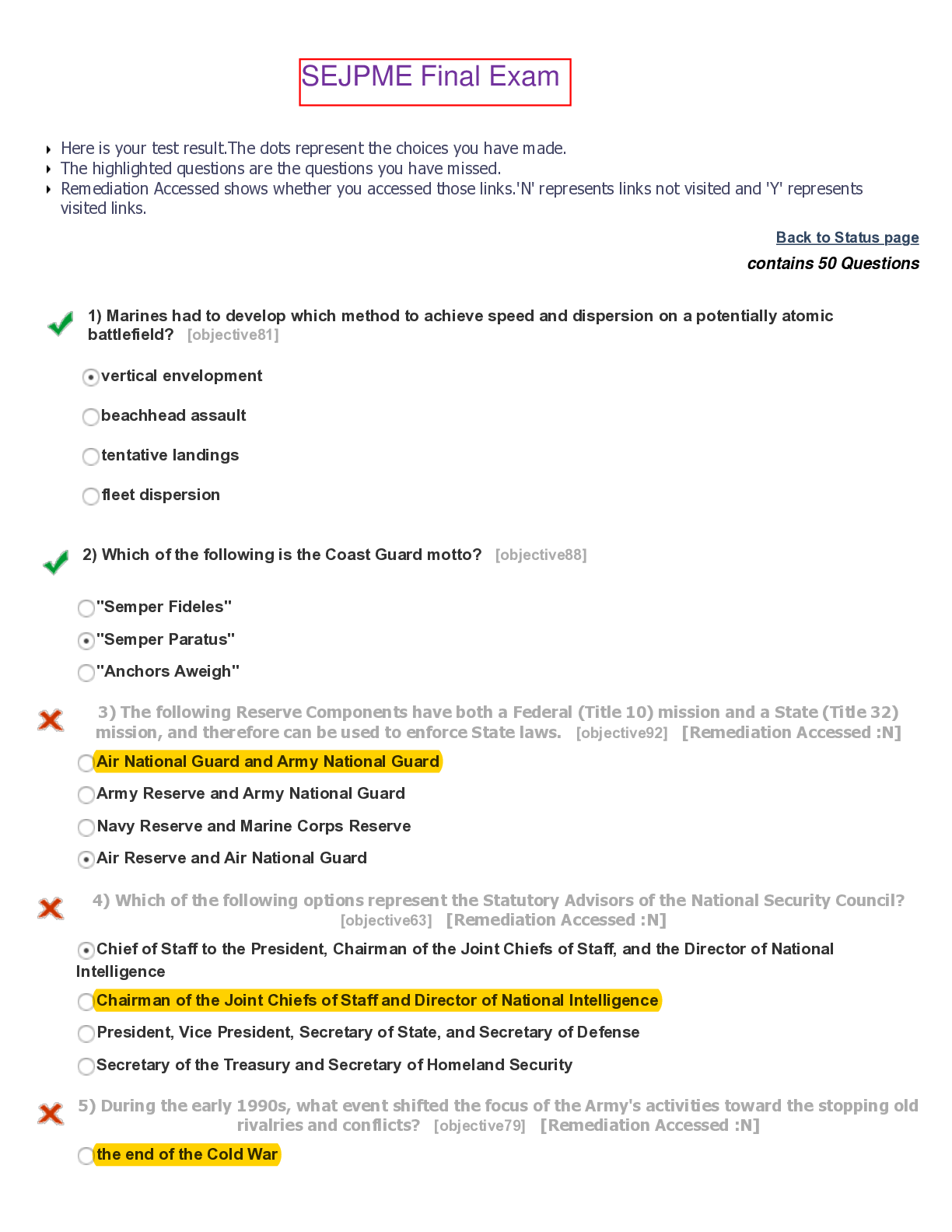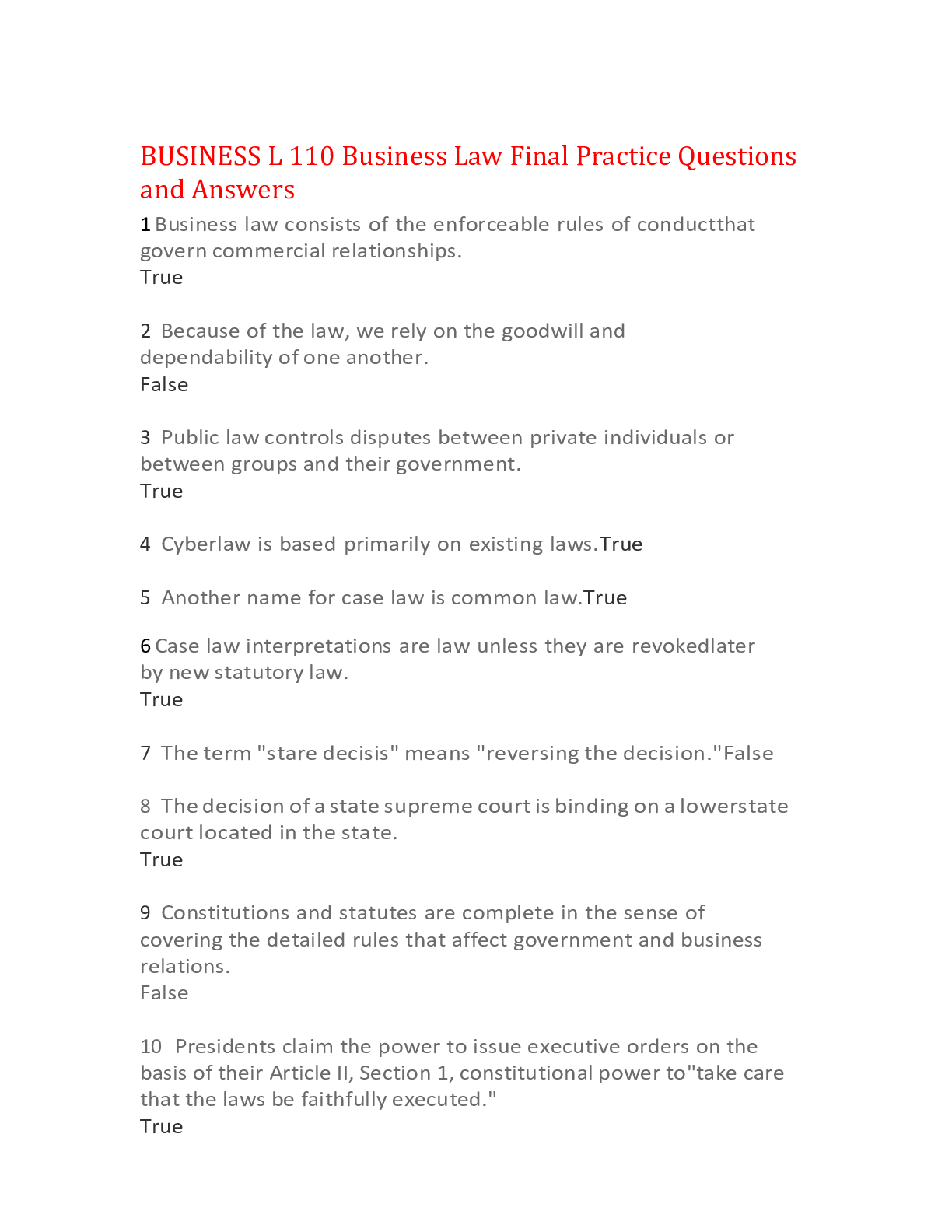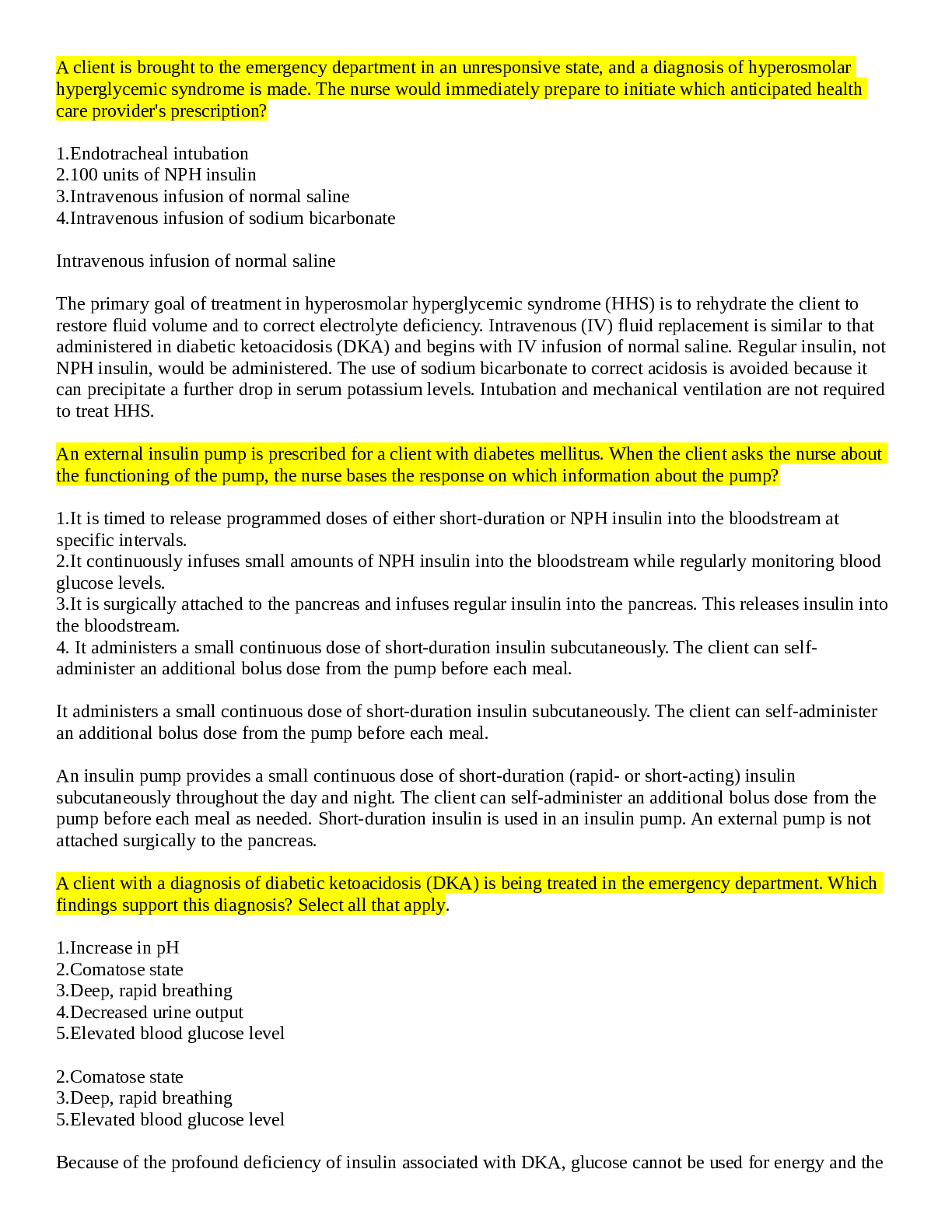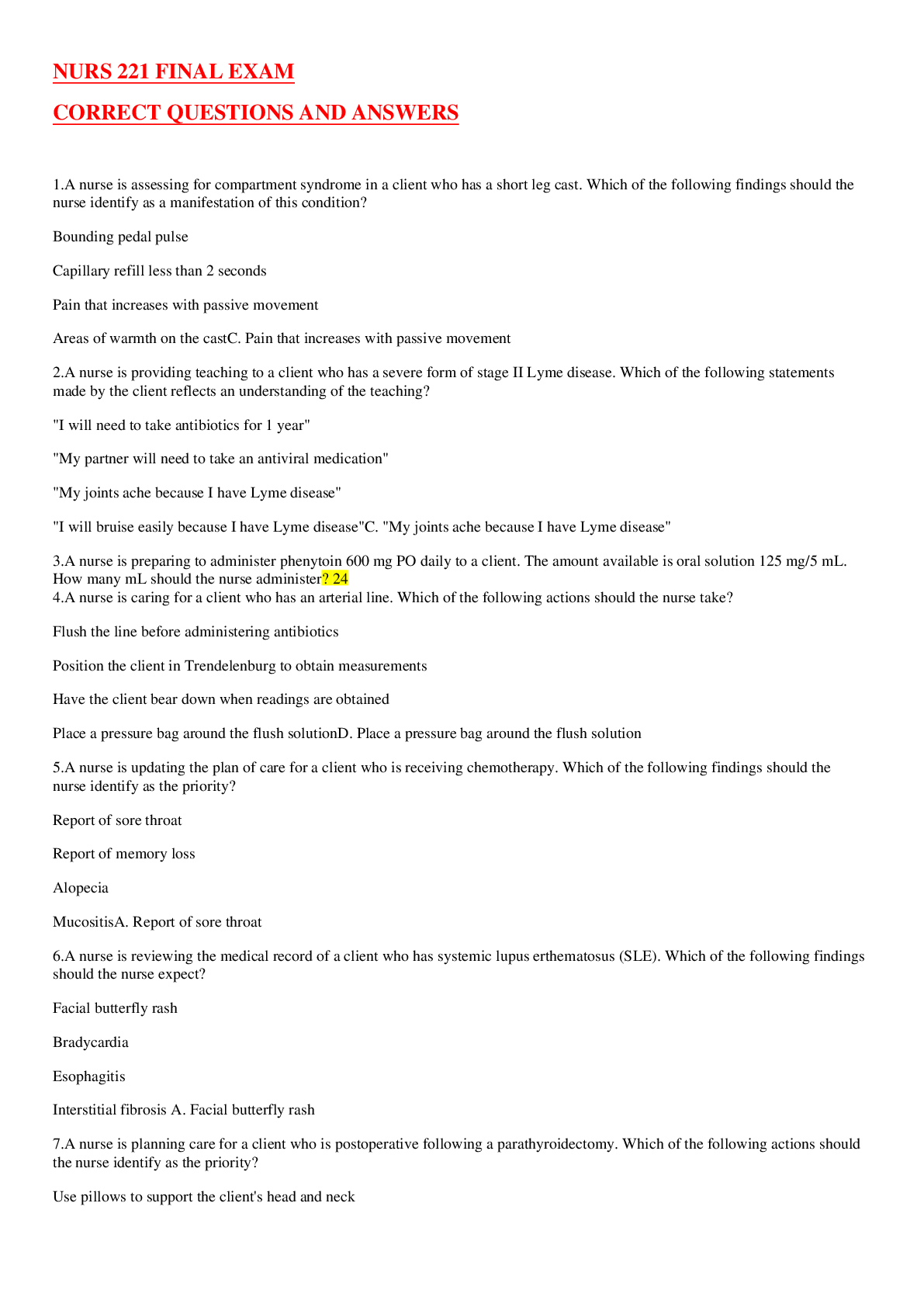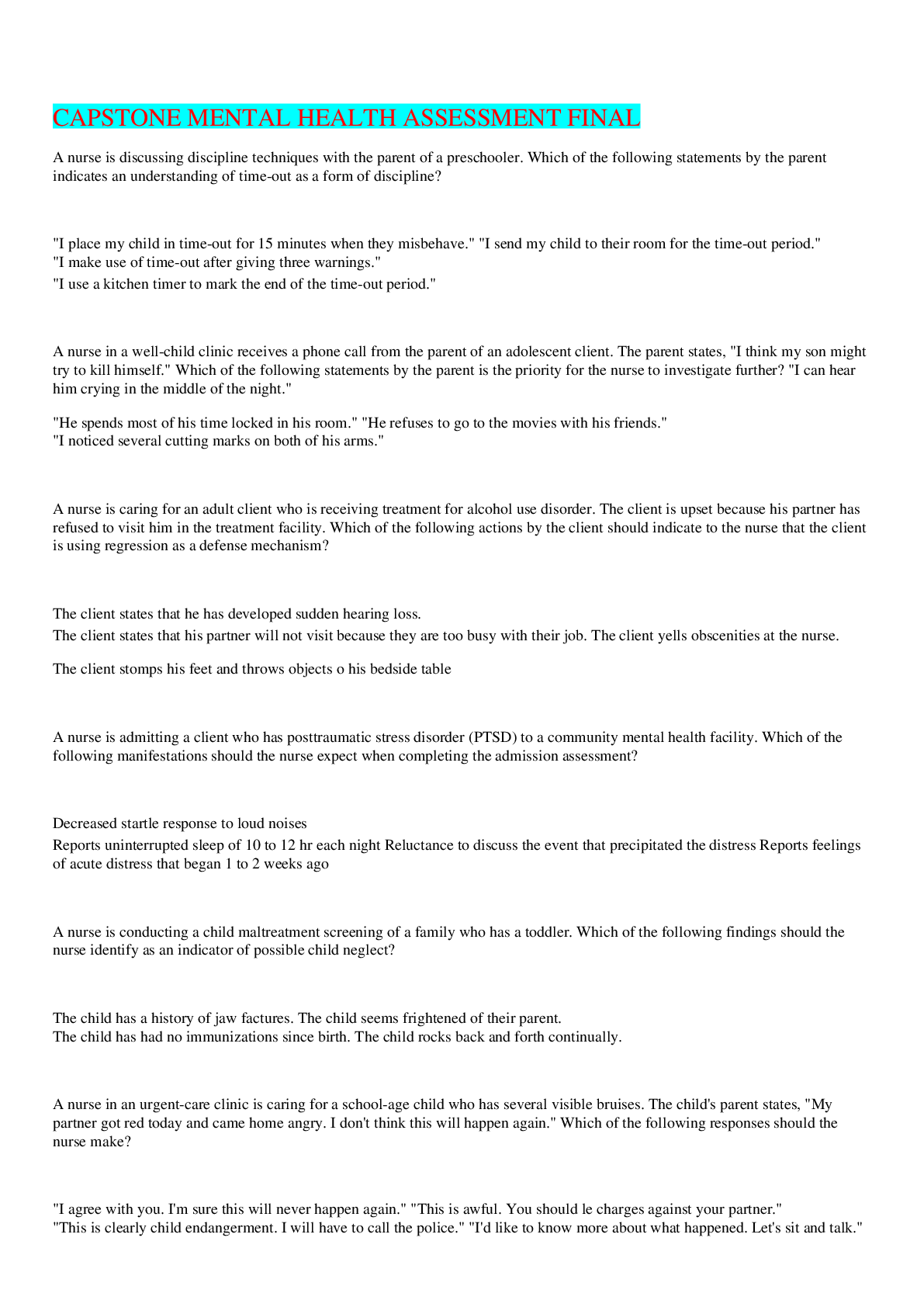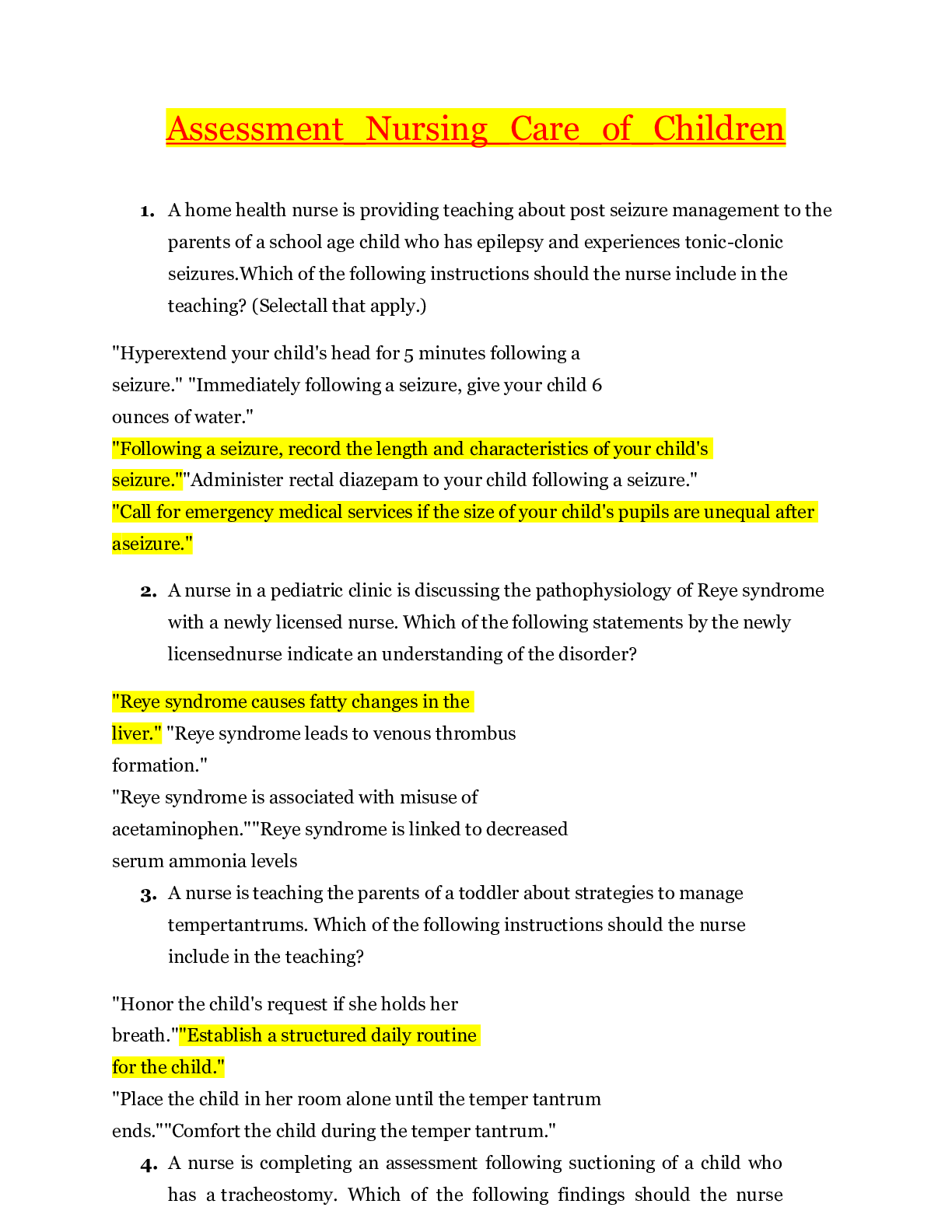AMLS Pretest and Post Test Questions and Answers,100% CORRECT
Document Content and Description Below
AMLS Pretest and Post Test Questions and Answers A 28 year old female is being evaluated for an acute onset of an alteration in mentation. She complained of a stiff neck and persistent headache. Vi... tal signs are P112, R22 and regular, BP 144/88, SpO2 95% and T 102.3F (39C). The healthcare provider should observe for which complication? Seizure -Chapter 2 A 45 year old patient is found supine on the floor of the Triage area. Healthcare providers note pinpoint pupils, shallow respirations and vomitus in and around the mouth. What course of action should be implemented next? Supplemental oxygen and suction -Chapter 2 Patients with a history of chronic bronchitis that present with shortness of breath are likely to have which condition? Pulmonary embolism -Chapter 3 Acute Respiratory Distress Syndrome (ARDS) is characterized by what pathological change? Breakdown of fluid between the alveolar-capillary membrane -Chapter 3 An anxious male complains of a sore throat, fever, chills, dental pain and dyspnea. the patient has a firm, red pronounced swelling in the sublingual anterior throat area and tongue. What diagnosis is most likely? Ludwig's angina -Chapter 3 Patients on mechanical ventilation may have hypoxemia due to alveolar collapse from mucous plugging. The best treatment for this is: Administer PEEP -Chapter 3 Anaphylaxis is most associated with which physiological event? Vasodilation -Chapter 4 An elderly patient in an assisted living facility presents with a diminished level of consciousness and elevated white blood count. Assessment reveals pale, clammy skin and a urinary catherter with dark colored urine. Vital signs are P132, R 38 and shallow, BP 78/46, SpO2 91% and T 100.8°F (32.8°C). What classification of shock is the patient most likely experiencing? Distributive -Chapter 4 Healthcare providers are assessing a patient with pronounced jugular vein distention and muffled heart tones. Vitals are P 128, R 26, BP 74/52. What classification of shock should be suspected? Obstructive - Chapter 5 During compensatory shock, the renin-angiotensin-aldosterone system is activated to cause a/an: Increase in preload, afterload and re-absorption of sodium -Chapter 4 A 42 year old patient with a history of rheumatoid arthritis is taking glucocorticoids. Over the past two weeks, she complains of chronic fatigue, weakness, and loss of appetite with weight loss. Lab results indicate hyponatremia and hyperkalemia. What underlying diagnosis is suspected? Adrenal insufficiency -Chapter 6 Which condition should the healthcare provider consider to usually be a non-emergent, non-life threatening illness? Thoracic outlet syndrome -Chapter 5 Healthcare providers should use extreme caution with nitroglycerin when ST elevation is present in which ECG leads? II, III, aVF -Chapter 5 Which is a high-risk factor for intracerebral hemorrhage? Cocaine drug abuse -Chapter 2 What is the initial treatment for a patient experiencing Hyperosmolar Hyperglycemic Nonketotic Syndrome (HHNS)? Crystalloid IV fluid resuscitation -Chapter 6 What condition is most likely to cause respiratory acidosis? Narcotic overdose -Chapter 6 What is the most effective treatment for an unconscious patient in respiratory acidosis? Assisted bag-mask ventilation -Chapter 6 An autoimmune disease which produces antibodies that mimic the role of TSH and cause an increase in thyroid hormones is: Grave's disease -Chapter 6 Glucagon may not be effective treatment for a patient with hypoglycemia if they also have which underlying illness? Alcoholism -Chapter 6 A 24 year old has completed a triathlon on a hot, humid day. The athlete complains of a severe headache, muscle cramps and abdominal pain. As the patient history is obtained, the athlete becomes lethargic. What underlying electrolyte disturbance should the healthcare provider most likely suspect? Hyponatremia -Chapter 6 What is the sign on the ECG that will indicate a patient is experiencing hyperkalemia? Peaked T waves -Chapter 6 An 82 year old alcoholic complains of nausea, non-bloody vomiting and severe epigastric and right upper quadrant pain that radiates to the back. Palpation reveals epigastric tenderness without peritoneal signs. What working diagnosis should be considered most likely? Acute pancreatitis -Chapter 7 A 23 year old male complains of a productive cough, fever, chills and pleuritic chest pain that has worsened over 3 days. A physical exam reveals unilateral wheezing with shallow respirations. Vitals are P 128, R 26, BP 144/88, SpO2 90%, and T 102°F (38.8°C). What treatment should be performed? Supplemental Oxygen and immediate transport -Chapter 3 A patient with suspected gallbladder disease is asked to take a deep breath while the provider presses upward into the upper right quadrant. If the patient ceases inspiration due to increase pain while being examined, this is known as: Murphy's Sign -Chapter 7 The patient is alert and oriented presenting with hypotension, bradycardia, normal capillary refill and warm, dry skin. These are cardinal signs of which type of distributive shock? Neurogenic -Chapter 4 During what period of the communicable disease process will antibodies begin to reach detectable levels and the infected blood will test positive for exposure to a pathogen? Incubation -Chapter 8 The patient presents with a history of headache, weight loss, chest discomfort, night sweats and a persistent cough for several weeks. Which infectious disease is most likely occurring? Tuberculosis -Chapter 8 A lethargic patient presents with dilated pupils and vital signs of P 122, R 26 and BP 130/80. He admits to excessive ingestion of diphenhydramine. What response is the cause for the presenting signs and symptoms? Anticholinergic -Chapter 9 Organophosphate poisoning will present with which signs and symptoms? Salivation and incontinence of urine and liquid stool -Chapter 9 What medication classification should be administered to an uncooperative, agitated patient? Benzodiazepine -Chapter 9 A patient presents with mildly decreased mental status, slow respirations, bradycardia, hypotension, has a blood sugar of 42mg/dl (2.3 mmolL). This is most likely caused from excessive ingestion of: Beta blockers -Chapter 9 The patient complains of a deep burning discomfort diffusely throughout the epigastrium. This is an example of which type of pain? Visceral -Chapter7 A 24 year old female presents with lower right quadrant abdominal pain. Her skin is hot to the touch and she exhibits a Psoa Sign. She complains of nausea and vomiting for 2 days. What diagnosis is suspected? Appendicitis -Chapter 7 A known chronic alcoholic complains of the constant, severe mid-epigastric pain, nausea and blood- streaked emesis. The patient has a temperature of 101.9°F (38.8°C) and severe abdominal tenderness. What underlying diagnosis should be suspected? Pancreatitis -Chapter 7 What component of a patient's past medical history is most helpful in considering myocardial infarction as a working diagnosis? Familial heart disease history -Chapter 5 A patient describes an "aching" sensation in his chest. It occurred suddenly while resting and radiates to the jaw. He self administered 1 nitroglycerin tablet without relief and the 12 lead reveals a normal sinus rhythm with ST elevation in leads II, III, and aVF. What working diagnosis is most likely? Inferior wall myocardial injury -Chapter 5 Healthcare providers are managing a patient presenting with substernal chest discomfort. They describe the pain as "pressure-like" and it radiates to the jaw and left arm. The discomfort subsides with rest, oxygen and administration of nitroglycerin. What is the most likely working diagnosis? Angina pectoris -Chapter 5 Which infectious disease must have oxygen present to survive? Tuberculosis -Chapter 8 Which best practices help to prevent the spread of infectious disease? Handwashing before and after all patient contact and standard precautions -Chapter 8 Continuous positive airway pressure would be most appropriate in treating which patient? 22 year old with severe asthma and not responding to nebulizer treatments -Chapter 3 A patient has attempted suicide by ingesting ethylene glycol about 20 hours prior to arriving for treatment. Lung sounds reveal bilateral crackles and respirations of 30 with symptoms of pulmonary edema and cyanosis of the lips. The ECG reveals ventricular tachycardia. Which stage of ethylene glycol poisoning has occurred? 2 -Chapter 9 A patient with a history of Grave's disease presents with anxiety, profuse sweating and a palpable goiter. Vitals are P 151, R 35 and labored, BP 84/42. Which working diagnosis is most likely? Thyrotoxicosis -Chapter 6 A patient experiences unilateral facial weakness and droop, garbled speech, altered sense of taste and no extremity weakness. The patient has a history of Lyme's disease. What condition is the patient likely experiencing? Bell's palsy -Chapter 2 Which component of the history is most crucial when assessing a potential stroke patient? Time of onset -Chapter 2 The determination of a working diagnosis is dependent on the provider's assessment, critical thinking and ____________________ __________________________ skills. Pattern recognition -Chapter 1 When performing a patient assessment, what information provides the most essential information in determining a working diagnosis? Medical history -Chapter 1 Clinical reasoning requires the healthcare provider to: Process relevant information, filter out irrelevant information -Chapter 1 According to the AMLS Assessment Pathway, determining whether a patient is "Sick or Not Sick" is initially done which component of the assessment process? First impression Select an example of a communication barrier that impairs an efficient and thorough assessment process. The patient can't find his hearing aid -Chapter 1 Healthcare providers are treating an unresponsive patient who overdosed on lorazepam. What intervention should be initiated? Airway support -Chapter 9 AMLS Post Test Questions and answers 2022 1. A 45-year-old patient is found supine on the floor. Healthcare providers note pinpoint pupils, shallow respirations, and vomitus in and around the mouth. What course of action should be taken next? a. Initiate an IV and administer naloxone b. Supplemental oxygen and suction c. Obtain a blood glucose level d. Begin BVM ventilations b. Supplemental oxygen and suction 2. Patients with a history of COPD that present with an acute onset of shortness of breath are likely to have what condition? a. Pulmonary embolism b. Angina pectoris c. Angioedema d. Hypertensive crisis a. Pulmonary embolism 3. During compensatory shock, the renin-angiotensin-aldosterone system is activated to cause a/an: a. Increase in preload, afterload, and re-absorption of sodium b. Decrease in preload, afterload, and re-absorption of sodium c. Hypotension and bradycardia d. Vasodilation and sodium retention a. Increase in preload, afterload, and re-absorption of sodium 4. What clinical findings are most commonly associated with a pulmonary embolus? a. Clear breath sounds with tachypnea b. Rhonchi auscultated bilaterally with hypercarbia c. Crackles heard in the bases with bradycardia d. Fever, tachycardia, and tachypnea with increased work of breathing a. Clear breath sounds with tachypnea 5. What condition is most likely to cause respiratory acidosis? a. Anxiety/panic attack b. Narcotic overdose c. Methanol ingestion d. Diabetic ketoacidosis b. Narcotic overdose 6. A 55-year-old complains of an 'aching' chest discomfort that persists over several days. The patient has a temperature of 101F (38.3C). Which finding will help narrow the diagnosis to pericarditis? a. Pain is relieved when supine b. Pulsus alternans is present c. S3 gallop is auscultated d. ST-segment elevation in all leads d. ST-segment elevation in all leads 7. Anaphylaxis is most associated with which physiological event? a. Hemorrhage b. Vasodilation c. Bradycardia d. Hypertension b. Vasodilation 8. Acute Respiratory Distress Syndrome (ARDS) is characterized by what pathological change? a. Excessive mucous production b. Inflammation of the visceral pleura c. Breakdown of the alveolar-capillary membrane d. Accumulation of fluid between the pleural layers c. Breakdown of the alveolar-capillary membrane 9. Continuous positive airway pressure would be most beneficial in treating which patient? a. A 43yo with a decreased LOC with respiratory difficulty b. A 22yo with severe asthma who is not responding to nebulizer treatments c. A 38yo with carpal pedal spasms, clear lung sounds, and respirations of 40/min d. A 55yo with jugular vein distension and a BP of 90/60 b. A 22yo with severe asthma who is not responding to nebulizer treatments 10. What is the initial treatment for a patient experiencing hyperosmolar hyperglycemic nonketotic coma (HHNC)? a. Crystalloid IV fluid administration b. Administration of dextrose c. Administration of insulin d. Fluid bolus of 5% dextrose in water (D5W) a. Crystalloid IV fluid administration 11. Your patient has had a seizure secondary to a nerve agent exposure. What medication would be best to diminish the seizure? a. Atropine b. Diphenhydramine c. Midazolam d. Pralidoxime c. Midazolam 12. Respiratory alkalosis may occur as a result of: a. Fever and anxiety b. Renal failure and dehydration c. Airway obstruction and chest wall pain d. Prolonged vomiting a. Fever and anxiety 13. An age-related change that increases the risk of respiratory compromise is: a. Increase of mucus production b. Increase in intrathoracic volume c. Decrease in lung compliance d. Decrease in dead space ventilation c. Decrease in lung compliance 14. Paroxysmal nocturnal dyspnea is most common in patients with a history of: a. Left-sided heart failure b. Pneumonia c. Asthma d. Multiple sclerosis a. Left-sided heart failure (?) 15. The patient presents with a history of fever and an upper respiratory infection. Historical information reveals increasing water intake, orthostatic hypotension, and an increase in urination. You suspect these symptoms are caused by: a. Hyperglycemia b. Hypoglycemia c. Hypokalemia d. Respiratory acidosis a. Hyperglycemia 16. You are dispatched to the home of a 32yo patient with a history of Graves' disease. The patient was in the ER earlier today for some "tests for my ulcers." He received contrast and was discharged. He is now complaining of not feeling well, chest pain, and palpitations. You note an anxious patient with fine tremors. He is diaphoretic and has a temperature of 101.5F, BP 100/62, P 156 (sinus tach), R 30, glucose level 133. Which of the following are management considerations for this patient? a. Aspirin (ASA) b. Fluids restriction c. Amiodarone d. Beta blockers d. Beta Blockers 17. Metabolic acidosis is best described by which arterial blood gas interpretation? a. pH elevated, pCO2 elevated, H2CO3 normal range b. pH decreased, pCO2 decreased, H2CO3 low c. pH decreased, pCO2 elevated, H2CO3 normal range d. pH elevated, pCO2 elevated, H2CO3 normal low b. pH decreased, pCO2 decreased, H2CO3 low (?) 18. The AMLS Assessment Pathway first advises safety and initial observations of the scene. The second process described in this pathway asks the healthcare provider to: a. Perform a focused physical exam b. Obtain diagnostic information c. Identify and manage life threats d. Reassess and refine the diagnosis c. Identify and manage life threats 19. Observing a patient's body positioning can be an early indicator that the patient is: a. Sick or not sick b. Does not speak the same language as the provider c. Has family who can provide historical information d. Diagnosed with multiple underlying medical conditions a. Sick or not sick 20. Which assessment finding is crucial to obtain from a patient suspected of a stroke? a. Last oral intake b. Medication allergies c. Onset of symptoms d. Risk factors c. Onset of symptoms 21. A 62yo patient presents with a severe headache. It is described as a "thunderclap" accompanied with nausea, blurred vision, and an elevated blood pressure. What neurologic condition is most likely the cause of this patient's presentation? a. Brain abscess b. Ischemic stroke c. Epidural hematoma d. Subarachnoid hemorrhage d. Subarachnoid hemorrhage 22. A 38yo presents with mild chest tightness and urticaria after mowing the lawn. He felt a "sting" in his left lower leg and states the symptoms came on suddenly. BP 130/82, P 100, R 20 with a normal work of breathing and clear lung sounds. The healthcare provider should: a. Immediately transport to the receiving facility b. Initiate an IV with 0.9% NS and monitor the patient carefully c. Initiate an IV with 0.9% NS and administer 0.5mg of epinephrine d. Obtain a blood glucose level b. Initiate an IV with 0.09% NS and monitor the patient carefully 23. Healthcare providers are treating a patient complaining of substernal chest pain accompanied with nausea and one episode of vomiting. The patient has had two cardiac stents placed within the last year. He has a familial history of heart disease and takes a baby aspirin daily. What information is most concerning? a. Familial history of heart disease b. Recent stent placement c. Nausea and vomiting d. Daily use of aspirin b. Recent stent placement 24. The patient complains of sharp chest pain that worsens when supine. He is bed ridden due to complications from a recent hip surgery. The patient is tachypneic and the ECG reveals sinus tachycardia. What is the patient's working diagnosis? a. Cardiac tamponade b. Gastroenteritis c. Pneumothorax d. Pulmonary embolism d. Pulmonary embolism 25. A patient is a resident in an assisted living facility to obtain physical therapy after a knee replacement surgery. She complains of a rash that is red and has small bumps. She has been feeling ill for several days. What is the most likely working diagnosis? a. Escherichia coli b. Shigellosis c. Methicillin-resistant Staphylococcus aureus d. Clostridum difficile c. Methicillin-resistant Staphylococcus aureus 26. A foreign exchange university student is found by his roommate and EMS is dispatched. The patient presents with an unusual flat red rash on his chest and arms. He has been ill with fever, nausea, and vomiting. Physical exam reveals stiffness of the neck. The healthcare provider will anticipate which diagnosis? a. Chicken pox (varicella) b. Meningitis c. Encephalitis d. H5, N1 (avian) influenza b. Meningitis 27. Healthcare providers are treating a 49yo male complaining of diffuse abdominal cramping. He has been ill with vomiting for 3 days. What working diagnosis is most probable? a. Appendicitis b. Cholecystitis c. Diverticulitis d. Gastroenteritis d. Gastroenteritis 28. While assessing your patient, you note he involuntary flexes the legs in response to flexing his neck. The patient is presenting with: a. A positive Murphy's sign indicating possible cholecystitis b. A positive Brudzinski's sign indicating possible meningitis c. A positive Psoas sign indicating possible meningitis d. The presence of a Babinski reflex indicating possible spinal cord lesion b. A positive Brudzinski's sign indicating possible meningitis 29. Healthcare providers are assessing an obese 49yo who is lethargic and has not been feeling well for several days. His family reports a history of extreme thirst. Vital sings are P 143, R 14, and BP 88/58. He takes medication for type 2 diabetes daily. What is the most probably working diagnosis? a. Thyroid storm b. Cushing's syndrome c. Diabetic ketoacidosis d. Hyperosmolar hyperglycemic nonketotic coma d. Hyperosmolar hyperglycemic nonketotic coma 30. A firefighter has been working a fire for 4 hours on a humid, hot day. He suddenly becomes nauseated and restless. The provider observes pupil dilation and an almond odor to his breath. The vital signs are P 56, R 22, BP 140/86. The ECG reveals sinus bradycardia with occasional PACs. Which toxin exposure has occurred? a. Carbon monoxide poisoning b. Cocaine overdose c. Ethanol poisoning d. Cyanide poisoning d. Cyanide poisoning 31. Healthcare providers are treating a patient that has taken an unknown amount of a prescribed pain medicine along with an OTC analgesic numerous times over the last 36 hours for chronic lumbar pain. The patient is experiencing abdominal pain, nausea, and vomiting. The providers note pallor and diaphoresis. Blood glucose is 42. What toxin overdose is suspected? a. Amphetamine b. Acetaminophen c. Barbiturate d. Benzodiazepine b. Acetaminophen 32. A patient complains of nausea and is passing black, tarry stools rectally. This patient is most likely suffering from: a. Cholecystitis b. Lower GI bleed c. Upper GI bleed d. Bowel obstruction c. Upper GI bleed 33. The provider assesses a patient suffering from fever, nausea, vomiting, and per-umbilical pain. Further evaluation reveals RLQ pain and lower back pain. A physical exam reveals an increase in RLQ pain when the patient's right leg is extended from the hip (Psoas Sign). Which working diagnosis is most appropriate? a. GI bleed b. Acute pancreatitis c. Pleural effusion d. Appendicitis d. Appendicitis 34. Intra-abdominal bleeds, like pancreatitis, often present with discoloration or bruising around the umbilicus. This physical exam finding is known as: a. Cullen's sign b. Roving's sign c. Psoas sign d. Murphy's sign a. Cullen's sign 35. Which of the following is a hallmark sign of tricyclic antidepressant toxicity? a. Dysrhythmias b. Rash c. Drooling d. Hyperventilation a. Dysrhythmias 36. A daughter states that her 72yo mother has a history of hypertension, high cholesterol, and rheumatoid arthritis. Daily medications include aspirin, Tenormin, Plaquenil, and Plavix. She is concerned as her mother has mixed up her medications and is now lethargic with diminished respirations. Vital signs are P 58 and regular, R 10 and shallow, and a BP of 90/74. Blood glucose is 52. Which medication toxicity would be indicative of this presentation? a. Calcium channel blockers b. Salicylate c. Beta blocker d. Anticoagulant c. Beta blocker 37. If untreated, a cardiac tamponade will present with signs and symptoms of which type of shock? a. Hypovolemia b. Neurogenic c. Obstructive d. Cardiogenic c. Obstructive 38. A patient presents anxious with difficulty in breathing and chest pain. An assessment reveals hypotension, muffled heart tones, and distended neck veins. There is a past medical history of pericarditis. The provider notes that there is a decrease in systolic blood pressure when the patient inhales. Which diagnosis would be considered with this presentation? a. Acute coronary syndrome b. Cardiac tamponade c. Tension pneumothorax d. Pneumonia b. Cardiac tamponade (?) 39. The healthcare provider is assessing a 60yo female patient with complaints of indigestion and mild upper abdominal discomfort. This presentation should prompt the provider to: a. Perform a 12-lead ECG b. Place a gastric tube and assess for GI bleeding c. Listen for heart sounds and determine if pericardial fluid is present d. Don a mask, gown, and observe standard precautions in case of influenza a. Perform a 12-lead ECG 40. The most common underlying medical conditions found in patients with acute pancreatitis is: a. Gall stones and heavy alcohol use b. Esophageal varices and stomach ulcers c. Mallory-Weiss syndrome and nephritis d. Peptic ulcer disease and diverticulitis a. Gall stones and heavy alcohol use 41. A patient complaining of a 3-day history of left lower abdominal pain describes it as sharp and, during the focused physical exam, the pain intensifies during palpation over the site. Differentials should include: a. Ectopic pregnancy or diverticulitis b. Pancreatitis or gall bladder infection c. Peritonitis or intestinal obstruction d. Appendicitis or hepatitis a. Ectopic pregnancy or diverticulitis 42. A 22yo male has recently undergone a surgical procedure to repair an injury to thoracic vertebrae T4-T6. Assessment indicates the patient is alert and oriented, bradycardic, hypotensive, and has warm, dry skin. Which type of shock is most likely occurring? a. Hypovolemic b. Obstructive c. Cardiogenic d. Neurogenic d. Neurogenic 43. A caregiver for a quadriplegic patient notes an onset of difficulty in breathing and anxiousness in her patient. Further assessment shows a temperature of 1011.2F, P 128, BP 86/68, and R 24. Physical exam reveals the skin is warm and urine in the catheter is dark yellow and cloudy. This patient is most likely experiencing which type of shock? a. Hypovolemia b. Septic c. Obstructive d. Cardiogenic b. Septic 44. When assessing geriatric patients, infectious diseases are more difficult to identify for all of the following reasons EXCEPT: a. History may be difficult to obtain b. Fever may be absent c. Frequent presence of underlying chronic illnesses d. Heightened immune response is common d. Heightened immune response is common 45. A local business woman has returned from missionary work in South Africa. She is complaining of night sweats, chest discomfort, and a persistent cough for several weeks. Which underlying diagnosis is most likely causing these symptoms? a. Pneumonia b. Cytomegaly virus c. Tuberculosis d. Mononucleosis c. Tuberculosis 46. Healthcare providers are responding to a near-drowning at a local lake. The patient is experiencing uncontrolled shivering and complains of nausea and weakness. The patient had been treading water for 25 minutes and now presents with tachycardia and rapid respirations. Core body temperature is 93.2F (34C). Which diagnosis is most likely? a. Mild hypothermia b. Acute pulmonary edema c. Severe hypothermia d. Deep frostbite a. Mild hypothermia 47. An elderly patient is receiving nursing care at a home while recuperating from a recent knee surgery. A post-operative infection developed, and the patient has been on antibiotics for quite some time. She is complaining of a foul-smelling diarrhea, and abdominal cramping and loss of appetite. On the basis of this presentation, the provider should suspect: a. UTI b. Clostridium difficile c. Methicillin-resistant Staphylococcus aureus d. Escherichia coli b. Clostridium difficile 48. A 20yo female presents with a 2-day history of dyspnea, nonproductive cough, chest tightness, and audible wheezing. Further exam reveals no fever or stridor. The patient has rapid respirations with difficulty exhaling. Which diagnosis is most likely? a. Epiglottitis b. Respiratory syncytial virus c. Asthma d. Bronchiolitis c. Asthma 49. An elderly patient with a 1-week history of productive cough and wheezing notices an increase in difficulty breathing when grocery shopping. Further assessment reveals pursed lip breathing, rhonchi, and minimal jugular vein distension. Which diagnosis should the provider suspect? a. COPD b. Pulmonary embolism c. CHF d. Epiglottitis a. COPD 50. A 50yo female has called 9-1-1. She complains of shortness of breath and chest discomfort. Assessment reveals her skin is pale, moist, and cool. BP is 102/68, R 24 and labored with crackles, P of 130 and regular. Which type of shock is most likely occurring? a. Septic b. Obstructive c. Hypovolemic d. Cardiogenic d. Cardiogenic [Show More]
Last updated: 1 year ago
Preview 1 out of 20 pages
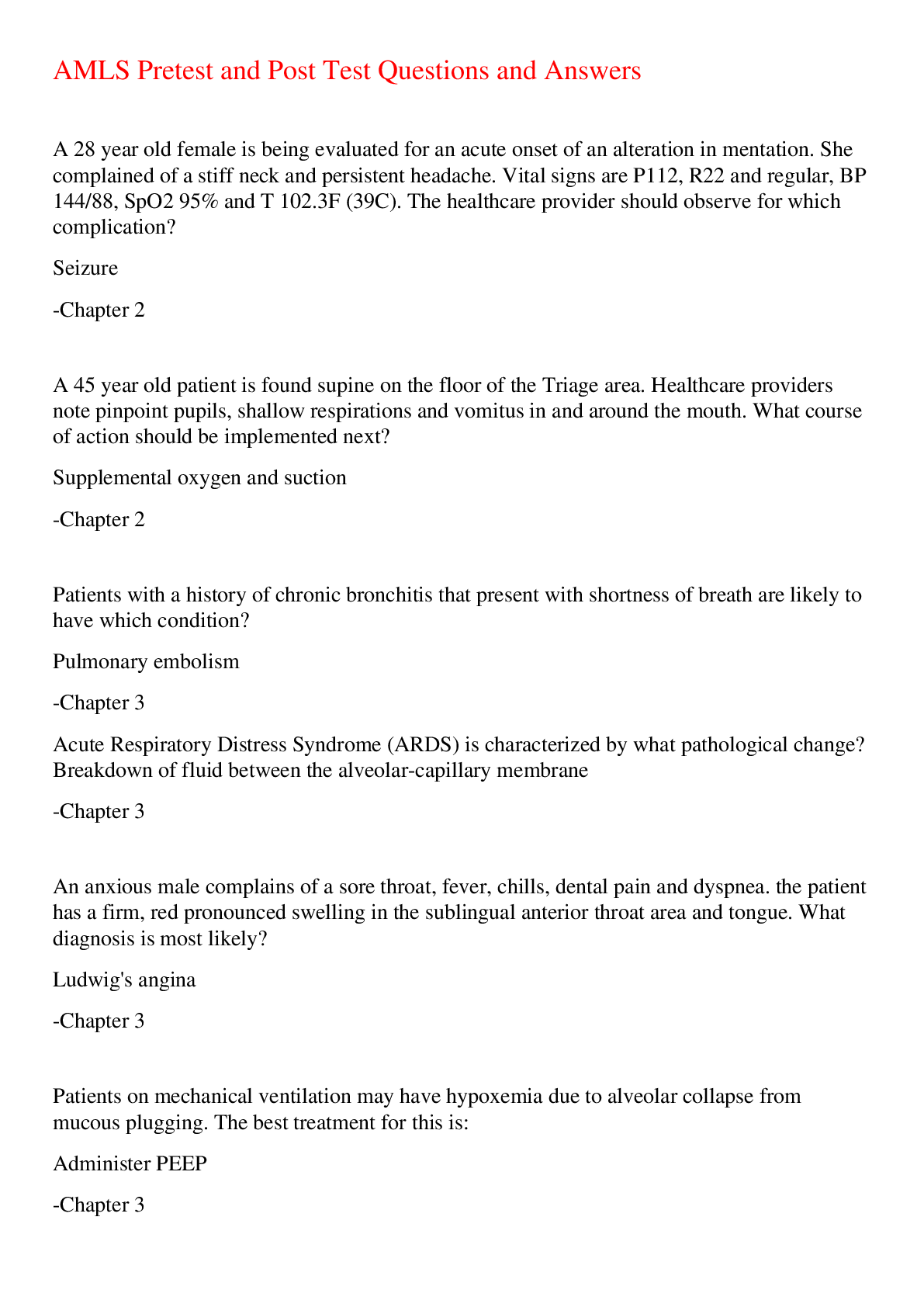
Reviews( 0 )
Document information
Connected school, study & course
About the document
Uploaded On
Apr 06, 2023
Number of pages
20
Written in
Additional information
This document has been written for:
Uploaded
Apr 06, 2023
Downloads
0
Views
25














